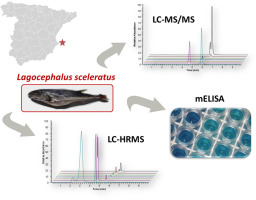Tetraodontidae is a family of marine and estuarine fish that includes 130 species grouped in 19 genera that are potential carriers of tetrodotoxins (TTXs) (Smith, 1986). Most puffer fish are from tropical waters but some have been found in temperate waters. Sphoeroides pachygaster is an expanding species that most probably reached the Mediterranean from the Atlantic Ocean and Lagocephalus lagocephalus is a circumglobal species, considered as native in the Mediterranean (Froese and Pauly, 2017). However, L. sceleratus only recently entered the Mediterranean Sea through the Suez Canal (Lessepsian migration) and is considered an invasive species. L. sceleratus was first reported in the Mediterranean Sea in February 2003 at Gökova Bay (southern Aegean Sea, Turkey) (Akyol et al., 2005), in November 2004 at Jaffa along the Israeli coast (Golani and Levy, 2005), and in July 2005 in the Cretan Sea, Greece (Kasapidis et al., 2007). Since then, L. sceleratus has been recorded with increasing frequency in Greece, Cyprus, Malta, Algeria, and Turkey and is considered as one of the fastest expanding Lessepsian invaders (Acar et al., 2017, Deidun et al., 2015, Kara et al., 2015, Katikou et al., 2009, Kosker et al., 2016, Rodriguez et al., 2012, Rousou et al., 2014). In Spain, one individual of L. sceleratus was captured in July 2014 in Denia (Alicante, Western Mediterranean) (Katsanevakis et al., 2014) and is the object of the present publication.
Tetrodotoxin is a neurotoxin responsible for human intoxications and fatalities, commonly following the consumption of puffer fish (Bane et al., 2014). Structurally, TTX consists of a guanidinium moiety connected to a highly oxygenated carbon skeleton that possesses a 2,4-dioxaadamantane portion containing five hydroxyl groups (Isbister and Kiernan, 2005). TTX co-exists with its naturally occurring analogues whose structures have already been described for at least 30 of them (Bane et al., 2014). In Japanese waters, the presence of puffer fish belonging to the Tetraodontidae family is very common. In fact, Japanese people are well-known consumers of fugu, which is considered a gastronomic delicacy. In humans, according to case studies, between 0.18 and 0.2 mg of TTX have been reported to cause severe symptoms, and a fatality was reported after an ingestion of around 2 mg of TTX (Noguchi and Ebesu, 2001).
Additionally, the Ministry of Health, Labour and Welfare published a guide with the edible parts and species of puffer fish that are allowed for consumption (HP of Ministry of Health) where L. sceleratus is not included among the edible species. However, TTX poisoning cases still occur in this and other Asian countries (Noguchi and Arakawa, 2008, Yotsu-Yamashita et al., 2011). In Europe, the current legislative requirements (European Commission, 2004a, European Commission, 2004b) establish that poisonous fish of the family Tetraodontidae and products derived from them must not be placed on the European markets. Despite this fact, accidental consumption of these species is possible. Since 2007, when the first toxic European episode was reported in Málaga (Spain) by the consumption of trumpet shells of the species Charonia lampas lampas containing TTXs (Rodriguez et al., 2008), several episodes along the Mediterranean coastal countries have been reported due to the consumption of puffer fish (Bentur et al., 2008, Kheifets et al., 2012). Very recently the presence of TTXs has been reported in gastropods from Portugal (Silva et al., 2012) as well as in bivalve mollusk shellfish grown at the south coast of England (Turner et al., 2015), along the Greek coast (Vlamis et al., 2015) and in the Netherlands (RASFF, 2016). Following these events, the European Food Safety Authority (EFSA) has recently published an opinion on the risks for public health related to the presence of TTX and TTX analogues in marine bivalves and gastropods (EFSA, 2017).
The aim of this work was to characterise the toxin profile of different Tetraodontidae species including the L. sceleratus caught in Denia (Alicante, Western Mediterranean). To this purpose, different puffer fish tissues were analysed by liquid chromatography coupled to tandem mass spectrometry (LC-MS/MS), liquid chromatography coupled to high resolution mass spectrometry (LC-HRMS), and a self-assembled monolayer-based enzyme-linked immunosorbent assay (mELISA).

